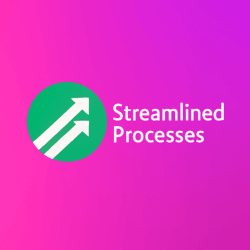For Business Task Automation Software, see our main page here.
What Is Business Task Automation Software?
Business Task Automation Software is a tool used by companies to automate repetitive, rule-based tasks. These platforms help streamline workflows, reduce manual entry, and improve reliability in daily operations. In other words, it replaces routine tasks with consistent, error-free automation.
For example, automating invoice processing, employee onboarding, or customer follow-ups saves employees time and cuts down on human errors. As a result, businesses can focus on high-value activities instead of spending hours on manual tasks.
This article was created with the assistance of AI tools and reviewed by our team at Streamlined Processes LLC to ensure accuracy and relevance.
Key Benefits of Business Task Automation Software
Investing in automation improves multiple areas of business performance. Below are some of the main advantages of using Business Task Automation Software:
- Increased Efficiency: Automating tasks speeds up processes, so work is completed faster and with fewer pauses.
- Cost Savings: Reduces labor costs by freeing employees from time-consuming manual operations.
- Error Reduction: Minimizes mistakes caused by manual input or inconsistent procedures.
- Better Compliance: Ensures regulatory steps are followed without forgetting key rules or policies.
- Scalability: Makes it easier to handle workload spikes without hiring extra staff.
Use Cases Across Industries
Business Task Automation Software isn’t just for large enterprises. Companies of all sizes in various industries use it to solve unique challenges.
- Retail: Automatically manage inventory updates and restock alerts.
- Healthcare: Automate appointment scheduling, billing, and patient record management.
- Finance: Streamline expense reporting, invoice processing, and transaction approvals.
- Marketing: Schedule social media posts or automate customer segmentation and email workflows.
- Human Resources: Handle onboarding paperwork, time-off requests, and payroll updates seamlessly.
For instance, a mid-size marketing agency used automation to schedule over 100 campaigns monthly. Consequently, the team reduced turnaround time by 35% and improved client satisfaction.
Features to Look for in Business Task Automation Software
Not all automation tools are the same. To clarify, high-performing software should include:
- Drag-and-Drop Interface: Allows non-technical users to build workflows easily.
- Integration Capabilities: Works with your existing CRM, ERP, or productivity tools.
- Conditional Logic: Lets tasks trigger based on specific rules or data sets.
- Real-Time Reporting: Tracks performance metrics and alerts users to issues quickly.
- Security Controls: Ensures sensitive data is protected and access is regulated.
Yet, over-complicated software can slow adoption. Therefore, ease of use should always be a top priority.
Selecting the Right Tool for Your Business
Choosing the right Business Task Automation Software involves assessing your organization’s size, structure, and goals. Start by answering key questions:
- What repetitive tasks consume the most time?
- Which departments struggle with bottlenecks?
- Do we need integrations with existing tools?
- What level of AI or analytics do we require?
For example, startups may benefit from lightweight tools like Zapier or Make. In contrast, enterprise settings might require platforms like UiPath or Microsoft Power Automate because of their depth and data handling power.
How AI Is Enhancing Business Task Automation Software
Modern Business Task Automation Software often includes AI capabilities to make workflows smarter, not just faster. AI enables functions such as natural language processing, predictive analytics, and intelligent decision-making.
For example, AI-powered bots can understand email content to decide which workflow to trigger next. In the same vein, machine learning algorithms can flag anomalies in financial reports instantly. Consequently, businesses can make better decisions with less delay.
Moreover, these features are becoming more accessible even to non-technical users, helping more teams adopt automation confidently.
Common Missteps to Avoid
While automation brings big benefits, poor planning can cause setbacks. Below are some mistakes to watch out for:
- No Clear Goals: Automating tasks without clear objectives wastes time and budget.
- Over-automation: Not every process needs to be automated. Some require human judgment.
- Poor Integration Planning: Software that doesn’t sync with your tools creates gaps in workflow.
- Not Training Staff: Users need to understand how to work with new systems to ensure results.
Above all, automation works best when aligned with overall business objectives. Therefore, it pays to involve relevant stakeholders early in the process.
Trends Driving Adoption of Business Task Automation Software
The automation market is growing fast. According to Gartner, spending on hyperautomation technologies will reach over $596 billion in 2024. Here’s why more businesses are ready to invest:
- Remote Work: Automation fills gaps created by decentralized teams and staggered schedules.
- Workflow Standardization: Businesses want predictable results across locations or teams.
- AI Accessibility: Open-source and low-code tools make intelligent automation more achievable.
- Rising Competition: Companies need to move faster and cheaper to stay ahead.
In conclusion, the demand for smarter tools will keep growing as more teams focus on productivity and accuracy.
FAQs About Business Task Automation Software
What tasks are best suited for automation?
Tasks that are repetitive, rule-based, and time-consuming—like data entry, notifications, and approvals—are ideal.
Is Business Task Automation Software expensive?
Pricing varies widely. Many tools offer tiered plans to fit small businesses or growing enterprises. ROI often justifies the cost.
Can I customize workflows without coding?
Yes. Most modern platforms offer visual builders or drag-and-drop tools designed for non-developers.
What are some popular options?
Popular platforms include Zapier, Make, Monday.com, Kissflow, and Power Automate. Your choice depends on your specific needs and tech stack.
Does automating tasks reduce jobs?
Not necessarily. Automation often shifts employees to more strategic roles, rather than displacing them entirely.
Final Thoughts
Business Task Automation Software helps teams work smarter, not harder. It improves speed, cuts costs, and unlocks time for innovation. As technology evolves, so will the tools for managing routine business tasks effectively.
Regardless of company size, automation can deliver real results—especially when properly planned, executed, and maintained over time.
Follow us on Facebook here.

